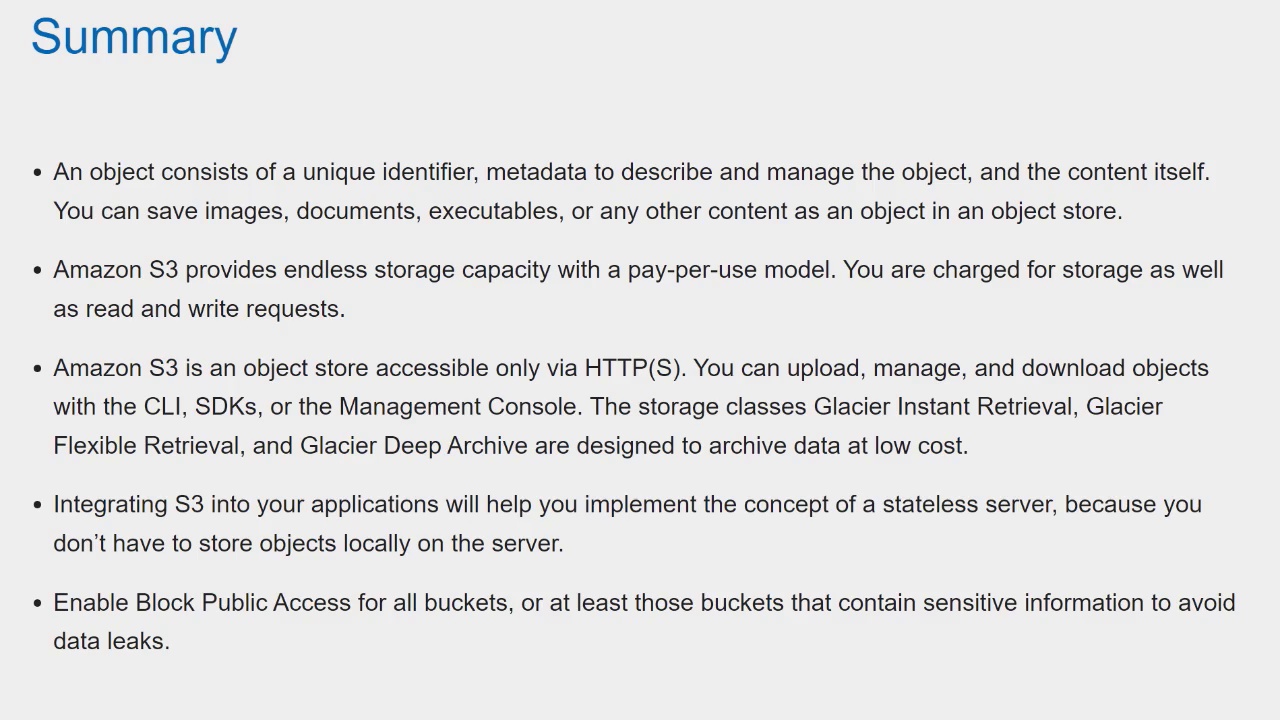001. Part 1. Getting started
002. Chapter 1. What is Amazon Web Services
003. Chapter 1. What can you do with AWS
004. Chapter 1. How you can benefit from using AWS
005. Chapter 1. How much does it cost
006. Chapter 1. Comparing alternatives
007. Chapter 1. Exploring AWS services
008. Chapter 1. Interacting with AWS
009. Chapter 1. Creating an AWS account
010. Chapter 1. Creating a budget alert to keep track of your AWS bill
011. Chapter 1. Summary
012. Chapter 2. A simple example WordPress in 15 minutes
013. Chapter 2. Exploring your infrastructure
014. Chapter 2. How much does it cost
015. Chapter 2. Deleting your infrastructure
016. Chapter 2. Summary
017. Part 2. Building virtual infrastructure consisting of computers and networking
018. Chapter 3. Using virtual machines EC2
019. Chapter 3. Monitoring and debugging a virtual machine
020. Chapter 3. Shutting down a virtual machine
021. Chapter 3. Changing the size of a virtual machine
022. Chapter 3. Starting a virtual machine in another data center
023. Chapter 3. Allocating a public IP address
024. Chapter 3. Adding an additional network interface to a virtual machine
025. Chapter 3. Optimizing costs for virtual machines
026. Chapter 3. Summary
027. Chapter 4. Programming your infrastructure The command line, SDKs, and CloudFormation
028. Chapter 4. Using the command-line interface
029. Chapter 4. Programming with the SDK
030. Chapter 4. Infrastructure as Code
031. Chapter 4. Using AWS CloudFormation to start a virtual machine
032. Chapter 4. Summary
033. Chapter 5. Securing your system IAM, security groups, and VPC
034. Chapter 5. Keeping the operating system up-to-date
035. Chapter 5. Securing your AWS account
036. Chapter 5. Controlling network traffic to and from your virtual machine
037. Chapter 5. Creating a private network in the cloud Amazon Virtual Private Cloud (VPC)
038. Chapter 5. Summary
039. Chapter 6. Automating operational tasks with Lambda
040. Chapter 6. Building a website health check with AWS Lambda
041. Chapter 6. Adding a tag containing the owner of an EC2 instance automatically
042. Chapter 6. What else can you do with AWS Lambda
043. Chapter 6. Summary
044. Part 3. Storing data in the cloud
045. Chapter 7. Storing your objects S3
046. Chapter 7. Amazon S3
047. Chapter 7. Backing up your data on S3 with AWS CLI
048. Chapter 7. Archiving objects to optimize costs
049. Chapter 7. Storing objects programmatically
050. Chapter 7. Using S3 for static web hosting
051. Chapter 7. Protecting data from unauthorized access
052. Chapter 7. Optimizing performance
053. Chapter 7. Summary
054. Chapter 8. Storing data on hard drives EBS and instance store
055. Chapter 8. Instance store Temporary block-level storage
056. Chapter 8. Summary
057. Chapter 9. Sharing data volumes between machines EFS
058. Chapter 9. Creating a mount target
059. Chapter 9. Mounting the EFS filesystem on EC2 instances
060. Chapter 9. Sharing files between EC2 instances
061. Chapter 9. Tweaking performance
062. Chapter 9. Backing up your data
063. Chapter 9. Summary
064. Chapter 10. Using a relational database service RDS
065. Chapter 10. Importing data into a database
066. Chapter 10. Backing up and restoring your database
067. Chapter 10. Controlling access to a database
068. Chapter 10. Building on a highly available database
069. Chapter 10. Tweaking database performance
070. Chapter 10. Monitoring a database
071. Chapter 10. Summary
072. Chapter 11. Caching data in memory Amazon ElastiCache and MemoryDB
073. Chapter 11. Cache deployment options
074. Chapter 11. Controlling cache access
075. Chapter 11. Installing the sample application Discourse with CloudFormation
076. Chapter 11. Monitoring a cache
077. Chapter 11. Tweaking cache performance
078. Chapter 11. Summary
079. Chapter 12. Programming for the NoSQL database service DynamoDB
080. Chapter 12. Creating tables
081. Chapter 12. Adding data
082. Chapter 12. Retrieving data
083. Chapter 12. Removing data
084. Chapter 12. Modifying data
085. Chapter 12. Recap primary key
086. Chapter 12. SQL-like queries with PartiQL
087. Chapter 12. DynamoDB Local
088. Chapter 12. Operating DynamoDB
089. Chapter 12. Scaling capacity and pricing
090. Chapter 12. Networking
091. Chapter 12. Comparing DynamoDB to RDS
092. Chapter 12. NoSQL alternatives
093. Chapter 12. Summary
094. Part 4. Architecting on AWS
095. Chapter 13. Achieving high availability Availability zones, autoscaling, and CloudWatch
096. Chapter 13. Recovering from a data center outage with an Auto Scaling group
097. Chapter 13. Architecting for high availability
098. Chapter 13. Summary
099. Chapter 14. Decoupling your infrastructure Elastic Load Balancing and Simple Queue Service
100. Chapter 14. Asynchronous decoupling with message queues
101. Chapter 14. Summary
102. Chapter 15. Automating deployment CodeDeploy, CloudFormation, and Packer
103. Chapter 15. Rolling update with AWS CloudFormation and user data
104. Chapter 15. Deploying customized AMIs created by Packer
105. Chapter 15. Comparing approaches
106. Chapter 15. Summary
107. Chapter 16. Designing for fault tolerance
108. Chapter 16. Considerations for making your code fault tolerant
109. Chapter 16. Building a fault-tolerant web application Imagery
110. Chapter 16. Summary
111. Chapter 17. Scaling up and down Autoscaling and CloudWatch
112. Chapter 17. Using metrics or schedules to trigger scaling
113. Chapter 17. Decoupling your dynamic EC2 instance pool
114. Chapter 17. Summary
115. Chapter 18. Building modern architectures for the cloud ECS, Fargate, and App Runner
116. Chapter 18. Comparing different options to run containers on AWS
117. Chapter 18. The ECS basics Cluster, service, task, and task definition
118. Chapter 18. AWS Fargate Running containers without managing a cluster of virtual machines
119. Chapter 18. Walking through a cloud-native architecture ECS, Fargate, and S3
120. Chapter 18. Summary



